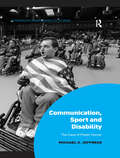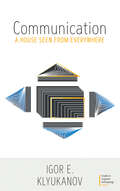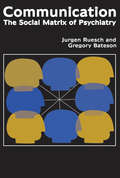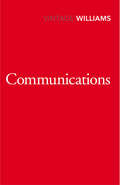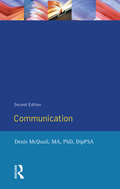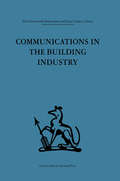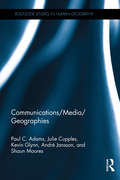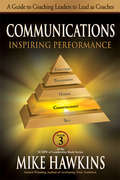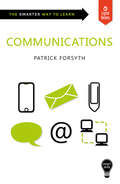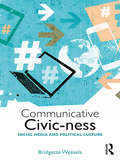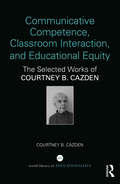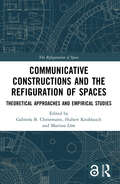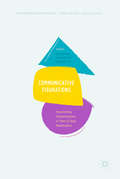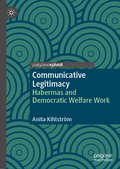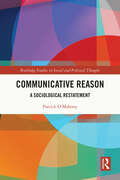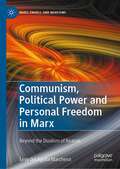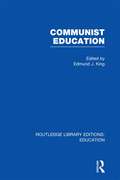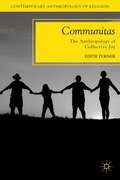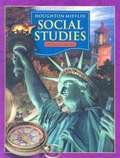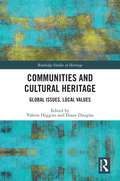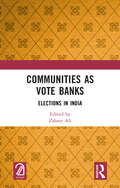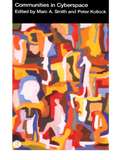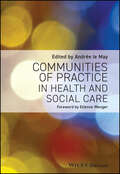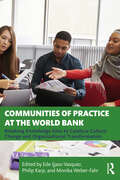- Table View
- List View
Communication, Sport and Disability: The Case of Power Soccer (Interdisciplinary Disability Studies)
by Michael S. JeffressSports are ubiquitous in American society, and given their prominence in the culture, it is easy to understand how most youth in the United States face pressure to participate in organized sports. But what does this mean for the hundreds of thousands of Americans who live with one or more physical disabilities and, in particular, those in powered wheelchairs? Located at the intersection of sports and disability, this book tells the story of power soccer - the first competitive team sport specifically designed for electric wheelchair users. Beginning in France in the 1970s, today, over sixty teams compete within the United States Power Soccer Association (USPSA) and the sport is actively played in over thirty countries. Using ethnographic research conducted while attending practices, games, and social functions of teams from across the nation, Jeffress builds a strong case that electric wheelchair users deserve more opportunity to play sports. They deserve it because they need the same physical and psychosocial benefits from participation as their peers, who have full use of their arms and legs. It challenges the social constructions and barriers that currently stand in the way. Most importantly, this book tells the story of some amazing power soccer athletes. It is a moving, first-hand account of what power soccer means to them and the implications this has for society.
Communication: A House Seen from Everywhere (Studies in Linguistic Anthropology #2)
by Igor E. KlyukanovFocusing on the scientific study of communication, this book is a systematic examination. To that end, the natural, social, cultural, and rational scientific perspectives on communication are presented and then brought together in one unifying framework of the semiotic square, showing how all four views are interconnected. The question of whether the study of communication can be considered a unique science is addressed. It is argued that communication is never separate from any object of study and thus we always deal with its manifestations, captured in the four scientific perspectives discussed in the book.
Communication: The Social Matrix of Psychiatry
by Gene Combs Gregory Bateson Jurgen Ruesch Eve C. PinskerThe integration of psychiatry into the mainstream of American society following World War II involved rethinking and revision of psychiatric theories. While in the past, theories of personality had been concerned with the single individual, this pioneering volume argues that such theories are of little use. Instead, the individual must be seen in the context of social situations in which rapid advances in communication technology have brought people closer together, changing their behavior and self-expression. Ruesch and Bateson show that following World War II mass communication and culture have become so pervasive that no individual or group can escape their influences for long. Therefore, they argue that processes of psychoanalysis must now consider the individual within the framework of a social situation. Focusing upon the larger societal systems, of which both psychiatrist and patient are an integral part, they develop concepts that encompass large-scale events as well as happenings of an individual nature. They have outlined this relationship in a unified theory of communication, which encompasses events linking individual to individual, individual to the group, and ultimately, to events of worldwide concern. The term "social matrix," then, refers to a larger scientific system, of which both the psychiatrist and the patient are integral parts. Jurgen Ruesch was professor of psychiatry at the University of California School of Medicine and director of the section of Social Psychiatry at the Langley Porter Neuropsychatric Institute in San Francisco. Gregory Bateson taught at Columbia University, the New School for Social Research, Harvard University, Stanford University, and the University of California, Santa Cruz. Among his books are "Naven", "Steps to an Ecology of Mind, Mind and Nature: A Necessary Unity", "Angels Fear: Towards an Epistemology of the Sacred", and "A Sacred Unity: Further Steps to an Ecology of Mind".
Communications
by Raymond WilliamsWilliams's fascinating investigation into forms of communication as they stood in 1962 - computers, radio, television, printing, photography, film - remains remarkably relevant today. The idea that reality is primary, and that communication of that reality secondary, is debunked - if we take the view that there is life, and then afterwards accounts of it, we degrade art and learning. Communications are, he argues, a major way in which reality is continually formed and changed. This is Williams's compelling introduction to modern means and institutions of communication.
Communications (Aspects of Modern Sociology)
by Denis McQuail, MA, PhD, DipPSAFirst published in 1985. Routledge is an imprint of Taylor & Francis, an informa company.
Communications in the Building Industry: The report of a pilot study
by Gurth Higgin Neil JessopTavistock Press was established as a co-operative venture between the Tavistock Institute and Routledge & Kegan Paul (RKP) in the 1950s to produce a series of major contributions across the social sciences. This volume is part of a 2001 reissue of a selection of those important works which have since gone out of print, or are difficult to locate. Published by Routledge, 112 volumes in total are being brought together under the name The International Behavioural and Social Sciences Library: Classics from the Tavistock Press. Reproduced here in facsimile, this volume was originally published in 1965 and is available individually. The collection is also available in a number of themed mini-sets of between 5 and 13 volumes, or as a complete collection.
Communications/Media/Geographies (Routledge Studies in Human Geography)
by Julie Cupples Kevin Glynn Shaun Moores André Jansson Paul C. AdamsAlthough there are human geographers who have previously written on matters of media and communication, and those in media and communication studies who have previously written on geographical issues, this is the first book-length dialogue in which experienced theorists and researchers from these different fields address each other directly and engage in conversation across traditional academic boundaries. The result is a compelling discussion, with the authors setting out statements of their positions before responding to the arguments made by others. One significant aspect of this discussion is a spirited debate about the sort of interdisciplinary area that might emerge as a focus for future work. Does the already-established idea of communication geography offer the best way forward? If so, what would applied or critical forms of communication geography be concerned to do? Could communication geography benefit from the sorts of conjunctural analysis that have been developed in contemporary cultural studies? Might a further way forward be to imagine an interdisciplinary field of everyday-life studies, which would draw critically on non-representational theories of practice and movement? Readers of Communications/Media/Geographies are invited to join the debate, thinking through such questions for themselves, and the themes that are explored in this book (for example, of space, place, meaning, power, and ethics) will be of interest not only to academics in human geography and in media and communication studies, but also to a wider range of scholars from across the humanities and social sciences.
Communications: Inspiring Performance (SCOPE of Leadership Book Series #3)
by Mike HawkinsGet results through the skillful exchange of information. Third in the “most comprehensive treatment of leadership I’ve ever seen by one author” (Jim Kouzes, coauthor of The Leadership Challenge).Communications: Inspiring Performance describes how to influence people through positive and trustworthy interpersonal communications. Great leaders speak, write, and listen in a manner that connects with people and moves them to action. By learning the competencies of creating compelling content, engaging the audience, and maintaining communication flow, you are able to capture people’s minds and hearts as well as foster the healthy exchange of ideas and information.The SCOPE of Leadership book series teaches the principles of a coaching approach to leadership and how to achieve exceptional results by working through people. You will learn a straightforward framework to guide you in developing, enabling, exhorting, inspiring, managing, and assimilating people. Benefit from the wisdom of many years of leadership, consulting, and executive coaching experience. Discover how to develop the competencies that align consistently with great leadership.
Communications: Smart Skills (Smart Skills)
by Patrick ForsythCommunication is one of the most basic functions in any organization. It transmits ideas, thoughts, information, opinions, and plans between various parts of an organization as well as to external customers or businesses – Its vital importance can never be over emphasized. Yet it can be difficult and communication breakdown is not uncommon. There are several essential elements to making business communications work; these include structure, clarity, consistency, medium, and relevancy and our guide covers those areas within the below chapters: •Essential foundations of success •Preparation •Face-to-face communication •Putting it in writing •Electronic Communication •On your feet •Being persuasive •Negotiating Our Smart Skill guide will enable you to target and convey your information through software, telephone or in-person methods. Regardless of what medium you use, effective communication means your message is received clearly and is understood entirely.
Communicative Civic-ness: Social Media and Political Culture
by Bridgette WesselsCommunicative Civic-ness explores how political culture shapes social media interactions in civic participation, arguing that social media usage is informed by context-specific civil and political culture. Drawing on cutting-edge research, the book develops a new robust theoretical and conceptual framework on civic engagement and participation, comprising: contextual ethos of civic communication; political culture and civic communication; use of social media in private and public spheres; design of social media. It critically addresses issues within the concept of political culture and develops the concept of ‘communicative civic-ness’. This concept seeks to aid a better-informed debate about the capacity of social media to support the pluralistic discussions that underpin deliberative democratic processes. This book appeals to both undergraduate and postgraduate students, as well as academics with an interest in areas including (but not limited to) sociology, political science and media studies. It will also provide useful information and understanding to third sector organisations and policy-makers regarding forms of civic participation.
Communicative Competence, Classroom Interaction, and Educational Equity: The Selected Works of Courtney B. Cazden
by Courtney B. CazdenIn the World Library of Educationalists series, international scholars themselves compile career-long collections of what they judge to be their finest pieces—extracts from books, key articles, salient research findings, major theoretical and/or practical contributions—so the world can read them in a single manageable volume. Readers thus are able to follow the themes and strands of their work and see their contribution to the development of a field, as well as the development of the field itself. Contributors to the series include: Michael Apple, James A. Banks, Joel Spring, William F. Pinar, Stephen J. Ball, Elliot Eisner, Howard Gardner, John Gilbert, Ivor F. Goodson, and Peter Jarvis. In this volume, Courtney B. Cazden, renowned educational sociolinguist, brings together a selection of her seminal work, organized around three themes: development of individual communicative competence in both oral and written language and discourse; classroom interaction in learning and teaching; and social justice/educational equity issues in wider contexts beyond the classroom. Since the 1970s, Cazden has been a key figure in the ethnography of schooling, focusing on children’s linguistic development (both oral and written) and the functions of language in formal education, primarily but not exclusively in the United States. Combining her experiences as a former primary schoolteacher with the insight and methodological rigor of a trained ethnographer and linguist, Cazden helped to establish ethnography and discourse analysis as central methodologies for analyzing classroom interaction. This capstone volume highlights her major contributions to the field.
Communicative Constructions and the Refiguration of Spaces: Theoretical Approaches and Empirical Studies (The Refiguration of Space)
by Gabriela B. ChristmannThrough a variety of empirical studies, this volume offers fresh insights into the manner in which different forms of communicative action transform urban space. With attention to the methodological questions that arise from the attempt to study such changes empirically, it offers new theoretical foundations for understanding the social construction and reconstruction of spaces through communicative action. Seeing communicative action as the basic element in the social construction of reality and conceptualizing communication not only in terms of the use of language and texts, but as involving any kind of objectification, such as technologies, bodies and non-verbal signs, it considers the roles of both direct and mediatized (or digitized) communication. An examination of the conceptualization of the communicative (re-)construction of spaces and the means by which this change might be empirically investigated, this book demonstrates the fruitfulness of the notion of refiguration as a means by which to understand the transformation of contemporary societies. As such, it will appeal to sociologists, social theorists, and geographers with interests in social construction and urban space.
Communicative Figurations: Transforming Communications in Times of Deep Mediatization (Transforming Communications – Studies in Cross-Media Research)
by Andreas Hepp Andreas Breiter Uwe HasebrinkThis book is open access under a CC BY 4. 0 license. This volume is about how to research the influence of our changing media environment. Today, there is not one single medium that is the driving force of change. With the spreading of various technical communication media such as mobile phone and internet platforms, we are confronted with a media manifold of deep mediatization. But how can we investigate its transformative capability? This book answers this question by taking a non-media-centric perspective, researching the various figurations of collectivities and organizations humans are involved in. The first part of the book outlines a fundamental understanding of the changing media environment of deep mediatization and its transformative capacity. The second part focuses on collectivities and movements: communities in the city, critical social movements, maker, online gaming groups and networked groups of young people. The third part moves institutions and organizations into the foreground, discussing the transformation of journalism, religion, politics, and education, whilst the fourth and final part is dedicated to methodologies and perspectives.
Communicative Legitimacy: Habermas and Democratic Welfare Work
by Anita KihlströmThis book analyses the legitimacy deficits in democratic welfare work using Habermas’ theories of communicative action, law and morality. Based on their underlying intersubjective perspectives, legitimacy problems can be identified and corrected, e.g. lack of confidence, dignity, respect, broken expectations, ignorance or mistrust of its administration. In modern societies with their many different contexts, a mutual understanding of facts, norms and expressions has become even more important in order to act constructively in daily life. These needs have increased the tension between the individual and the system, which becomes especially evident when globalised and individualised service users ask for welfare services. Therefore, professionals must develop an ability to understand how these legitimacy problems arise and how they can be dealt with democratically. This book responds to these needs, and will be of interest to students, scholars and practitioners working across democratic welfare, social policy, social work, and sociology.
Communicative Reason: A Sociological Restatement (Routledge Studies in Social and Political Thought)
by Patrick O'MahonyThe book examines philosophical and sociological approaches within critical theory and more widely from the vantage point of communicative reason. It seeks to revitalize the sociological dimension of critical theory by advancing a critical sociology of reason. It does so fully in the knowledge that reason is a contentious concept in sociology and other disciplines. Nonetheless, building on Habermas’s original insight, it argues that an extensively modified version of communicative reason is indispensable. This modified approach will draw extensively from Peirce’s pragmatist semiotics and critical cognitive sociology. Such a focus has significant implications for meta-theoretical, theoretical-empirical, and methodological approaches in critical theory, critical sociology, and related disciplines. This book will be of interest to readers in the social sciences, humanities, and philosophy who value the importance of a social theory of a reasonable society for their disciplines and for increasingly essential interdisciplinary activities. The book will also appeal to many in critical theory and beyond who are interested in the cognitive foundations of normative orders, including unjust or pathological as well as actually or potentially just foundations. The book emphasizes both validity and critique within communicative reason and critical theory and accordingly presents a distinctive perspective on critical-reconstructive research.
Communism, Political Power and Personal Freedom in Marx: Beyond the Dualism of Realms (Marx, Engels, and Marxisms)
by Levy del Aguila MarchenaThis book investigates communism in Marx’s writings, incorporating a consideration of communist politicity. The author outlines the arguments by which it is possible to sustain—from Marx—the idea that human emancipation against capital also means the elimination of the State, the public, and the political dimension of praxis. He also posits that the concrete tasks of the “management of the common” in a communist society require political mediations that allow us to confront the difference inherent to the personality of freely associated producers, as well as the ontological finitude from which no technical power can evade. Finally, assuming Marx as a starting point whose work remains an inescapable source for “thinking communism,” the book proposes a research agenda from Marx and beyond to continue in this imperative task.Levy del Aguila Marchena is Senior Professor and Chair of the Department of Management Sciences at the Pontificia Universidad Católica del Perú. He has published extensively on Marx, political philosophy, and applied ethics.
Communist Education (Routledge Library Editions: Education)
by Len Barton Martin LawnDevelopments and trends in Communist education are traced in this authoritative survey by specialists. Eight chapters deal with particular aspects: ideology, psychology, the selective process, the roles of teachers and parents, polytechnical education, the universities and professional institutes. Three chapters survey the former East Germany, Poland and China as special case-studies. A concluding chapter examines common ground between Communist and other systems.
Communitas
by Edith TurnerCommunitas is inspired fellowship; a group's pleasure in sharing common experiences; being 'in the zone' - as in music, sport, and work; the sense felt by a group when their life together takes on full meaning. The experience of communitas, almost beyond strict definition and with almost endless variations, often appears unexpectedly.
Communities
by Herman J. Viola Sarah Witham Bednarz Mark C. Schug Charles S. White Maryellen Vogt Cheryl Jennings Dolores Beltra Carlos E. CortésNIMAC-sourced textbook
Communities
by Herman J. Viola Sarah Witham Bednarz Mark C. Schug Charles S. White Maryellen Vogt Cheryl Jennings Dolores Beltra Carlos E. CortésNIMAC-sourced textbook
Communities and Cultural Heritage: Global Issues, Local Values
by Valerie HigginsCommunities and Cultural Heritage explores the relationship between communities, their cultural heritage and the global forces that control most of the world’s wealth and resources in today’s world. Bringing together scholars and heritage practitioners from nine countries, this book contributes to the ongoing dialogue on community heritage by analysing impediments to full community participation. The underminin of local communities comes at a high price. As the chapters in this book demonstrate, the knowledge embedded within traditional and Indigenous heritage creates communities that are more resilient to environmental and social stressors and more responsive to contemporary challenges such as climate change, environmental degradation, post-disaster recovery and relocation. Cultural heritage practices often fail to capitalise upon local knowledge and traditional skills and undervalue the potential contribution of local communities in finding creative and resourceful solutions to the issues they are confronting. Arguing that the creation of successful community heritage project requires ongoing reflection on the aims, methods, financing and acceptable outcomes of projects, the volume also demonstrates that the decolonization of Western-focussed heritage practices is an ongoing process, by which subaltern groups are brought forward and given a space in the heritage narrative. Reflecting on trends that impact communities and heritage sites across different geographical regions, Communities and Cultural Heritage will be of interest to academics, students and practitioners of cultural heritage,archaeology and anthropology around the world.
Communities as Vote Banks: Elections in India
by Zaheer AliIndian plurality is unique in the world. No other country can boast of having so many races, religions, castes, cultures, languages and regional diversities within its boundaries as India can. This plurality, while providing a very chequered and rich socio-cultural scenario, also impinges a few tensions that often lead to violent clashes. Since India is also the largest democracy in the world, its diversified society also influences the electoral scenario.This book compiles research papers by social scientists to analyze the electoral behavior of communities constituted on the basis of religion, caste and region. It also presents a critique of the role of media during elections, emphasizes the need to use latest technological devices to increase the involvement of the electorates, and proposes necessary and practical reforms in the process of elections to ensure better representation.Print edition not for sale in South Asia (India, Sri Lanka, Nepal, Bangladesh, Pakistan or Bhutan)
Communities in Cyberspace
by Marc Smith Peter KollockThis wide-ranging introductory text looks at the virtual community of cyberspace and analyses its relationship to real communities lived out in today's societies. Issues such as race, gender, power, economics and ethics in cyberspace are grouped under four main sections and discussed by leading experts: * identity* social order and control* community structure and dynamics* collective action. This topical new book displays how the idea of community is being challenged and rewritten by the increasing power and range of cyberspace. As new societies and relationships are formed in this virtual landscape, we now have to consider the potential consequences this may have on our own community and societies. Clearly and concisely written with a wide range of international examples, this edited volume is an essential introduction to the sociology of the internet. It will appeal to students and professionals, and to those concerned about the changing relationships between information technology and a society which is fast becoming divided between those on-line and those not.
Communities of Practice at the World Bank: Breaking Knowledge Silos to Catalyze Culture Change and Organizational Transformation
by Ede Ijjasz-Vasquez Philip Karp Monika Weber-FahrIllustrated by the experience of the World Bank, this book explains how knowledge management, traditionally viewed as being about information systems and processes, can play a fundamental corporate role by creating a competitive edge for organizations, increasing team performance, and fostering effective, large-scale organizational change. Rich and powerful stories, told by economic development practitioners and knowledge management specialists throughout the World Bank, describe the strategies, instruments, tools, and processes at the core of one of the most important and radical reorganizations of the world’s premier international development institution. Going far beyond other knowledge management titles, this book: shows how knowledge management can be a source of competitive advantage and team performance, rather than a back-room support function focuses on the role of the "software" of knowledge management, most notably the use of communities, culture, and collaboration across internal silos to create value; and demonstrates the role that knowledge management can play in fostering innovation, and development of new business lines and strategies by global teams in diverse locations Written not only for knowledge management professionals, but also for C-suite executives and middle managers who will see the benefits of bringing knowledge management to the core of organizational performance and competitive advantage, the book provides practical examples that can be replicated in other large global knowledge, financing, and development institutions and that will be relevant for public, private, and non-profit organizations.
